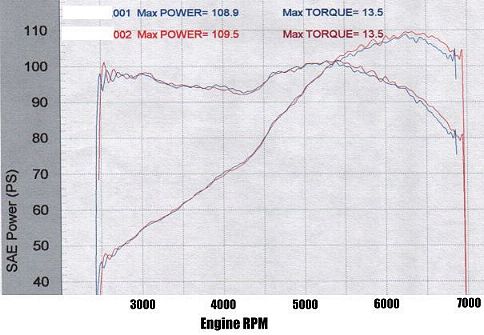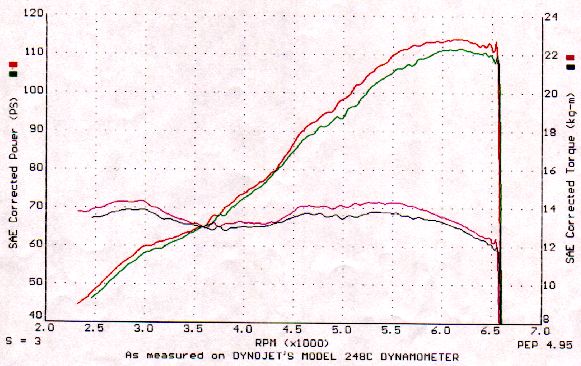
In our just concluded 3-part series on the Light-Pressure-Turbocharged 1.6SOHC, we have seen that with an LPT, the 1.6SOHC engine is able to deliver power levels comparable to that from the much higher tech'ed B16A engine. In the process, the turbo-charger also gave it a significantly more powerful mid-range, so much so that an LPT 1.6SOHC may very well be faster than its SiR brother ! However the LPT kit can be a very costly project. Many readers who were initially extremely excited by what they read eventually decided that despite their strongest desires, they are ultimately unable to afford the rather high asking price of such a modification project. Well, unfortunately quality do come with a price.
But what if, despite his strongest efforts, the 1.6SOHC owner really could not find the financial resources to do the LPT approach ? What is left now ? Is there indeed any hope left for the 1.6SOHC other than the LPT kit ?
I for one feels that despite the 'low tech' nature of the 1.6SOHC, one can still modify it to extract a reasonable level of power increase. I think the key is simply in setting the correct levels of expectations. After all, everyone will like to own the NSX-R as an example, but few are indeed fortunate enough to be able to afford one. So, not having the financial resources to afford the HKS LPT kit is no shame. If a reader do indeed fall into this category, the alternative will be the so-called "NA" approach. In fact, for those on a tight budget, this approach has the further advantage that it can be applied a step at a time, whenever the wallet permits. Nevertheless, physical laws do dictate that there is a definite limit to what one can squeeze out of an engine via the NA mean, so of course, acheiving the power levels of the mighty B16A is out of the question now. Well, what is a resonable expectation then; what is possible ?

An illustration of what is acheiveable comes from the car in this article. An EG generation 'SR3' Civic, this black hatchback is sold in Malaysia from 1991 to 1996 and carries the high performance flag for the Honda Civic during that period. Fitted with the same 1.6SOHC PGM-Fi engine as the manual LPT Civic in the previous article, the engine is spec'ed for 120ps with a red-line of 6800rpm. The car's kerb-weight is rather light though and this allowed the SR3 Civic to mix it up quite well with its competition on the streets.
NA tuning for the 1.6SOHC will most commonly be through bolt-on parts. The standard package applies here; open element air-filter, exhaust, and headers (usually 4-2-1). Also often thrown in will be the venerable spark plug cables as sometimes an adjustable fuel pressure regulator. The more well-off owners will add in an air-fuel regulator so as to fine tune the engine's operating air-fuel ratio for best power delivery.

A similar package is installed by the owner in his SR3 Civic in this article. The air-filter is the very popular K&N based Trust Airinx cone filter system, complete with the replacement of the rubber filter hose with one made from metal of the same diameter. To complement the better air ingestion is a custom made exhaust system, the 'cat-back', except that the cat actually originally do not exist in this car (the local Malaysian agent sells this generation Civic without a cat). The header is a custom 4-2-1 design for the 1.6SOHC by another local speedshop SpeedWorks under the HOT-BITS brand-name. Spark-plug cables are stock. An adjustable fuel pressure regulator was installed. The final item in the package is the popular Fields SFC fuel controller.
A tuning package of course takes care of the rest of the car as we have seen in the previous articles. In this case, the owner, being a keen 'weekend warrior' who frequents the local race-track on public Sunday sessions installed lowering springs from H&R. Shocks were stock. The braking system were also taken care off as well as a set of good rim and tyres.

This car did not have a base-line dyno so we have to work with derived engine power based on the reference power loss of 15% for a Honda FF manual transmission. The car went for a dyno session to correctly set the adjustable fuel pressure regulator, the SFC controller, as well as to set the base ignition timing at the distributor. This was done in conjunction with a couple of friends, all of them sharing a block of 2 hours of time on a Dynojet machine.
As it arrived, the car was apparently already fairly accurately set, dailing in at around 109ps at the wheels. As a result, attempting to set the fuel pressure regulator did not deliver any extra power. Setting the Fields SFC also only gave minor benefits to power delivery. However, setting the base ignition timing at the distributor did give clear benefits to top-rpm power; the car's final dyno-run topping 110ps at the wheels, with clear gains beyond the 6300rpm peak power point, almost 3ps gains from visual approximation from the dyno graph.
Using our 15% transmission power loss figure, 110ps at the wheels translates to ~129 - 130 ps at the engine flywheel. This represents around a 10ps or ~8% power gain. This then is what the 'NA-tuning' package acheived for the 1.6SOHC. Of course it is low when compared to what an LPT would have done but NA-tuning do have to work within physical limits.
The ~10ps/8% power gain may be viewed by some as relatively low, especially after getting used to results of 30% gain or more from the LPT kit. Since the NA tuning result is from one case, some readers may well wonder if this is an isolated case where the engine did not deliver. Fortunately, even this question can be answered quite well because I have on my hands, another dynojet chart for a similar Civic, this time an SR4 or 4-door sedan using the same 120ps 1.6SOHC engine. However, having only the dyno-chart, I do not have first hand examination of the car so I will have to rely on '2nd hand' information.

This 'C4M' (Civic 4-door Manual) came in for an HKS Super-Power-Flow upgrade as well as the very popular HKS AFR package. The 'AFR package' is a fixed price package where the HKS AFR is sold along with installation charges and a best-effort Dynojet tuning session to ensure the AFR is tuned for best power gains. From the dynochart notes, it was noted that the Civic was initially using a Sports Filter Element i.e. a drop-in replacement filter similar to the K&N. Since the dyno result was quite good, I also asked about other upgrades to the car and I was told it also had an exhaust/header upgrade.
The baseline dyno for the Civic as received, i.e. with a 'sports filter' which gives better air-flow than the stock paper element as well as the exhaust and header upgrade was ~112ps at the wheels. After replacement of the air-filter with the HKS Super-Power-Flow system and the tuning session with the HKS AFR, the Civic finally dyno'ed at 114ps at the wheels, a 2ps gain in max power. Again, merely looking at the result from the max-power point proved to be misleading. The Civic gained power all across the rpm band from the SPF/AFR package. At least 1ps gain was registered from as low as 2500rpm right until 4500rpm. Beyond 4500rpm, power gains increased to 4ps, reaching beyond 5ps around the 5500-6000rpm point. The max power rpm for the engine was around 6300rpm at which point, power gains of 2ps were still registered.
If we work backward from 114ps at the wheels, we will get an approximation of ~134ps at the engine or 14ps gain from the stock specification. 14ps for a 120ps spec engine will be around 12%. Comparing with the ~130ps for the 3-door Civic with which we started this article, the difference in power gain is only ~4ps or around 3%. This difference is relatively trivial and can well be considered to be within the limits of tolerances we would expect from the 1.6SOHC. In this sense, I believe both the dyno session results will give us a good degree of confidence to peg the expectation for power gains from the popular 'filter-exhaust-header-A/F' package to be around 10-12% over the specified stock power of the 1.6SOHC engine. In other words, around 130-135ps would be the max possible power that we can reasonably expect to derive from the 1.6SOHC with a bolt-on 'NA' upgrade package.

130-135ps at the engine. This level of power gain may look trivial if we compare it against the mighty B16A which has a similar displacement. But I insists that it is nothing to laugh at. The B16A benefits from a healthy dose racing technology, thanks to the VTEC mechanism. The 1.6SOHC does not. Therefore, without the benefit of an LPT, it will never be able to achieve even the max power levels of the B16A.
Using purely NA means, is there anything else that can be done ? Of course there is. But it would involve taking the engine apart, to implement things such as port and polish, racing camshafts, lightened flywheels, higher compression ratios e.t.c., all race technologies that were generously utilized on the B16A. In a 1.6SOHC without VTEC however, the use of such technologies will incur significant penalties in driveability and even reliability. In fact an often overlooked fact is that by the time a significant portion of the engine mods are implemented - and some good power gains have finally become available - the cost of doing such an NA package will have exceeded significantly that of an LPT kit. But this is not to say that all the world as far as modifying the 1.6SOHC is concerned is the LPT kit. Far from it indeed. But I do feel that 'NA tuning' of the 1.6SOHC should best be limited to the bolt-on package. For any significant increase in power, the best value for money will still be the LPT kit. An alternative is also available - the B16A engine. That will be the subject of our next - and final - article in our 1.6SOHC series.
I hope that this article will give readers a fair idea of what can be expected from the 1.6SOHC with a fairly comprehensive NA-based tuning package. Again such a package will popularly comprise the items of air-filter, exhaust, header, and an air-fuel regulator upgrade. Again, the use of such a package on the 1.6SOHC should give approximately 10% or so upgrade in max-power, upping the final max-power of the 1.6SOHC to around 130-135ps at the engine.
WongKN
August 2001
© Temple of VTEC Asia